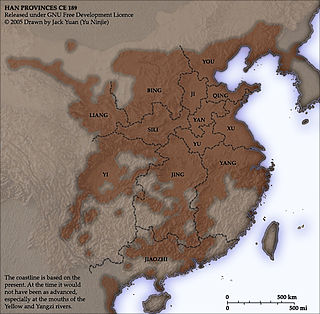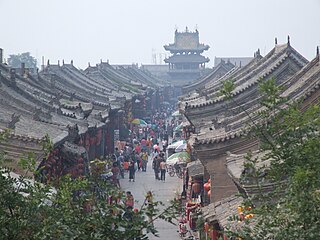
The Five Dynasties and Ten Kingdoms period (907-979) was an era of political upheaval in 10th-century Imperial China. Five states quickly succeeded one another in the Central Plain, and more than a dozen concurrent states were established elsewhere, mainly in South China. It was the last prolonged period of multiple political division in Chinese imperial history.

The Five Dynasties was an era of political upheaval in 10th-century China. Five states succeeded one another in the Central Plain. More than a dozen states, referred to as the Ten Kingdoms, were established elsewhere, mainly in south China.

The Northern Han kingdom was a state of the Five Dynasties and Ten Kingdoms period. It was founded by Liu Min (劉旻), formerly known as Liu Chong (劉崇), and lasted from 951 to 979.

Shu Yu of Tang, surname (姓): Ji (姬) given name (名): Yu (虞), and Ziyu (子於), was the founder of the State of Tang during the early Zhou Dynasty of ancient China. The State of Tang would later be renamed Jin by Shu Yu's son and successor, Xie. He was the son of King Wu of Zhou and the younger brother of King Cheng of Zhou.

The Sixteen Prefectures, more specifically the Sixteen Prefectures of Yan and Yun or the Sixteen Prefectures of You and Ji, comprise a historical region in northern China along the Great Wall in present-day Beijing and Tianjin Municipalities and northern Hebei and Shanxi Province, that were ceded by the Shatuo Turk Emperor Shi Jingtang of the Later Jin to the Khitan Liao dynasty in 938. The subsequent Later Zhou and Song Dynasties sought to recover the ceded northern territories. Most of the Sixteen Prefectures including the two principal cities, Youzhou and Yunzhou remained in Liao hands until the 1120s, when the Jurchens of the Jin dynasty conquered the region. In 1123, the Jurchens ceded most of the territories except Yunzhou to the Song, but retook them in 1125. The loss of the Sixteen Prefectures exposed the plains of central China to further incursions by the Jurchens and the Mongols.

The Later Han was founded in 947. It was the fourth of the Five Dynasties, and the third consecutive sinicized Shatuo ethnicity state, however, other sources indicate that the Later Han emperors claimed patrilineal Han Chinese ancestry. It was among the shortest-lived of all Chinese regimes, lasting for slightly under four years before it was overcome by a rebellion that resulted in the founding of the Later Zhou.
Liu Wuzhou was a rebel leader who rose against the rule of the Chinese dynasty Sui Dynasty late in the dynasty's history, and he took imperial style—although it was not completely clear whether the title he took was khan or tianzi. He was initially only able to take control of modern northern Shanxi and parts of central Inner Mongolia, but after Li Yuan established Tang Dynasty at Chang'an as its Emperor Gaozu in 618, he, with support from Eastern Tujue, briefly captured Li Yuan's initial power base of Taiyuan in 619, posing a major threat to Li Yuan's rule. In 620, Li Yuan's son Li Shimin counterattacked, and not only recaptured Taiyuan but further captured Liu's power base Mayi, forcing Liu to flee to Eastern Tujue. When Liu subsequently tried to flee back to Mayi, Eastern Tujue executed him.

Gujiao is a county-level city in Shanxi province, People's Republic of China. It is administered by the prefecture-level city Taiyuan. The estimated population of Gujiao in 2017 is about 222,000.

She County, or Shexian, is a county of southwestern Hebei province, China, located on the lower reaches of the Zhang River and bordering Shanxi to the west and Henan to the south. It is under the administration of the Handan City, with a population of 400,000 residing in an area of 1,509 km2 (583 sq mi).

Hunyuan County is a county under the administration of Datong City, in the northeast of Shanxi province, China.

Ningwu County is a county under the administration of Xinzhou in Shanxi province, China.
Bingzhou, or Bing Province, was a location in ancient China. According to legend, when Yu the Great tamed the flood, he divided the land of China into the Nine Provinces. Historical texts such as the Rites of Zhou, and "Treatise on Geography" section of the Book of Han, recorded that Bingzhou was one of the Nine Provinces. Bingzhou covered roughly the areas around present-day Baoding, Hebei, and Taiyuan and Datong in Shanxi.
Beijing, literally "northern capital" in Chinese, generally refers to the modern city of Beijing, the capital of the People's Republic of China.

Dai Prefecture, also known by its Chinese name Daizhou, was a prefecture (zhou) of imperial China in what is now northern Shanxi. It existed intermittently from AD 585 to 1912. Its eponymous seat Daizhou was located at Shangguan in Dai County. The territory it administered included all or part of what are now the counties of Dai, Wutai, Fanshi, and Yuanping in Shanxi's Xinzhou Prefecture.
Jin Yinhuan was a Chinese politician from Shanxi province.
Shanxi architecture, or Shansi architecture, or Jin architecture, refers to the architectural style of the Shanxi province in northern China. Shanxi has preserved numerous ancient architectures scattered throughout the province. All of the four remaining wooden structures preserved from Tang dynasty in China are found in Shanxi. The old buildings of Pingyao ancient city and numerous family compounds of Shanxi merchants in the Ming and Qing dynasties are representative of the architecture styles of vernacular architecture in North China. Religious temples in Mount Wutai and Yungang Grottoes in Datong exemplify the sacred buddhist architecture in China.



















